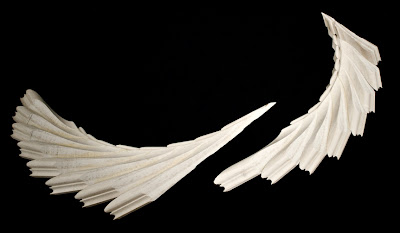Here are my note from
Deleuze's The Fold - Leibniz and the Baroque. This reading is an excerpt from the
book of the same name and it can be found in
AD Architecture and Science.
Deleuze’s work informs contemporary notions of society, subjectivity and creativity.
He favors a world where everything is in one mode of substance, in the same level of existence. There is no good and evil, only relationships that may be desirable or undesirable to particular individuals.
Two fundamental concepts:
Difference – there is no identity, only difference
Repetition – nothing is ever the same, everything is always changing, reality is becoming, not being
Deleuze was a constructivist; he argued that philosophers are not just interpreters, but creators of new concepts. In his work he often wrote about other philosophers, radically reinterpreting and freeing them from one fixed, dominate interpretation. This was a way of setting up an ‘encounter’ that would spawn new concepts. Deleuze believed that every reading of philosophy should set up this type of ‘encounter.’ For Deleuze, studying the work of another was inspirational, a resource for developing new ideas.
The Fold – Leibniz and the Baroque, is in this spirit. Deleuze re-evaluates Leibniz and derives new concepts to characterize the Baroque period. Deleuze argues that Leibniz is the philosopher whose thinking can best inform the Baroque and vice versa, in fact he claims that one cannot be fully understood without the other.
Leibniz’s theory of the monad – the whole universe is contained or reflected within each being.
The basic unit of existence is the fold. There are elements of folding in the Baroque and in Leibniz, but only in bringing them together, does the concept gain consistency.
The Baroque refers to an operative function, not an essence (a single style or formal language).
Two types of folds: the pleats of matter and the folds of the soul.
These folds are situated in a two-level regime, with pleats of matter below and folds of the soul above. This is a diagram of subjectivity or a way of thinking about how beings are simultaneously framing and being framed by the world they inhabit.
The first level contains matter folding into itself again and again, ‘caverns upon caverns.’ There are also beings in this level; the animate and inanimate are continuously folded together.
The second level contains the immaterial aspects of our subjectivities, ‘the folds of the soul.’ This level is closed in on itself.
There is another fold between the levels, a ‘style’ of being encompassing one of the many possible worlds expressed by the beings that inhabit it.
The fold implies a recursively curvilinear model of matter – “Matter thus offers an infinitely porous, spongy or cavernous texture without emptiness, caverns endlessly contained in other caverns...”
A fluid is the absence of coherence or cohesion, the complete separability of parts. Hardness is a cohesion or inseparability of parts. A body has a degree of fluidity and a degree of hardness. Neither the Cartesian hypothesis of complete fluidity or atomistic hypothesis of complete hardness holds.
Thus Leibniz proposes a flexible body that still has cohering parts – a series of recursive folds upon folds that apply divisions to the continuous rather than break into separate or unrelated parts.
In the model of matter as folds, relations (or continuities) are folds that may be realized in multiple ways.
The multiple – one that has been folded in many ways. A multiple is not a series of unrelated parts, but a way of thinking about complexity through interconnectedness rather than divergences.
An organism is defined by endogenous folds, folds that come from within, implying a type of sensibility, intelligence or agency.
Inorganic matter has exogenous folds that are determined from without, from the surrounding environment.
People are a type of folded being, folded from within and without. Our modes of being are complicated and manners of being are impossible to predict.
Modernist ‘machines for living’ expressed the needs of the mechanical body. What spaces will be invented for the folded multiplicitous body?
Plastic forces (folds) apt to foster connections, more apt to force change and more apt to evidence a degree of cohesion. “The living organism…by virtue of preformation has an internal density that makes it move from fold to fold…”
epigenesis vs. preformation – starting from material that is unformed and gradually taking shape over time vs. individuals that adhere to a form defined in advance.
A plastic organism can fold and unfold itself, not to infinity, but to extents allowed within a particular species.
Does folding produce truly different types? Or only differentiations along a continuum?































